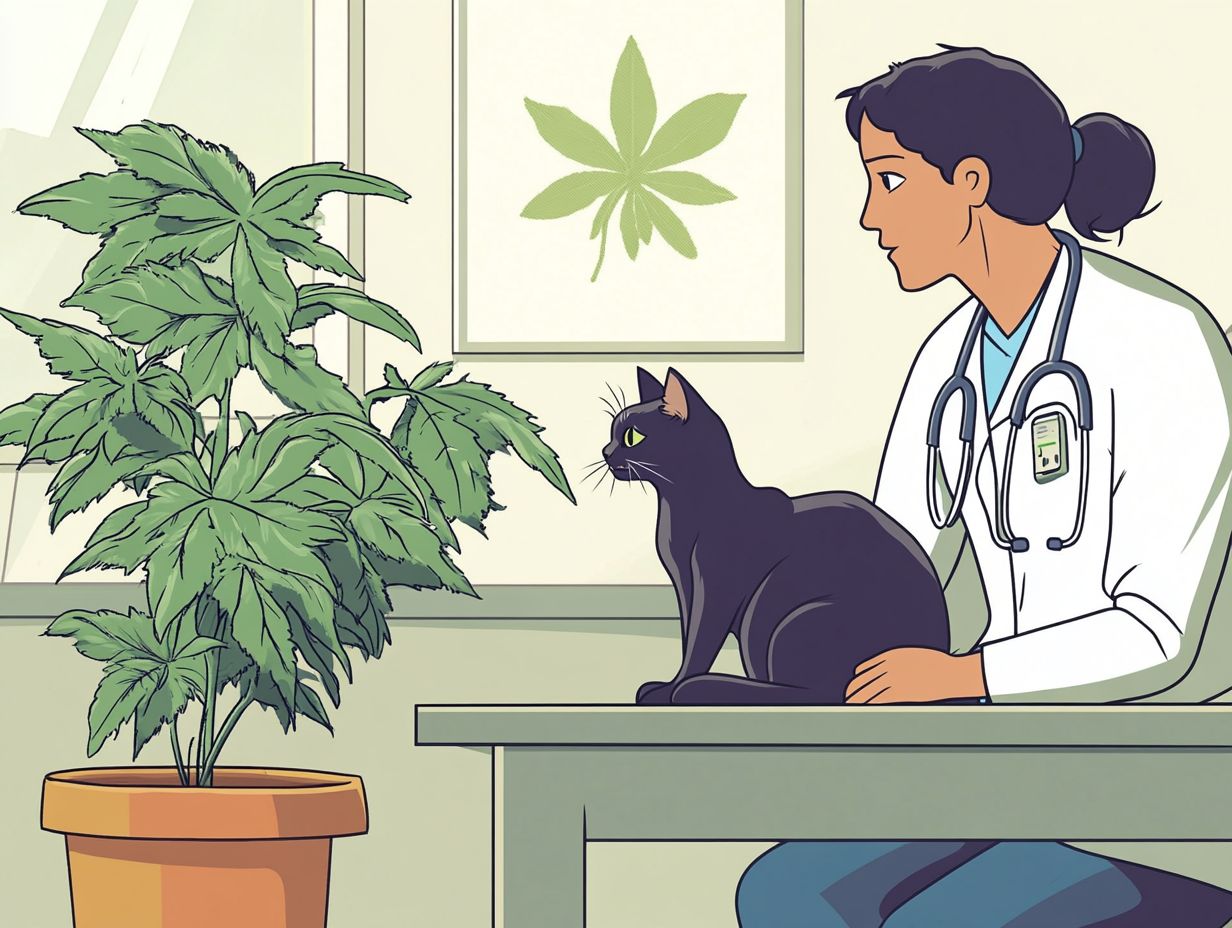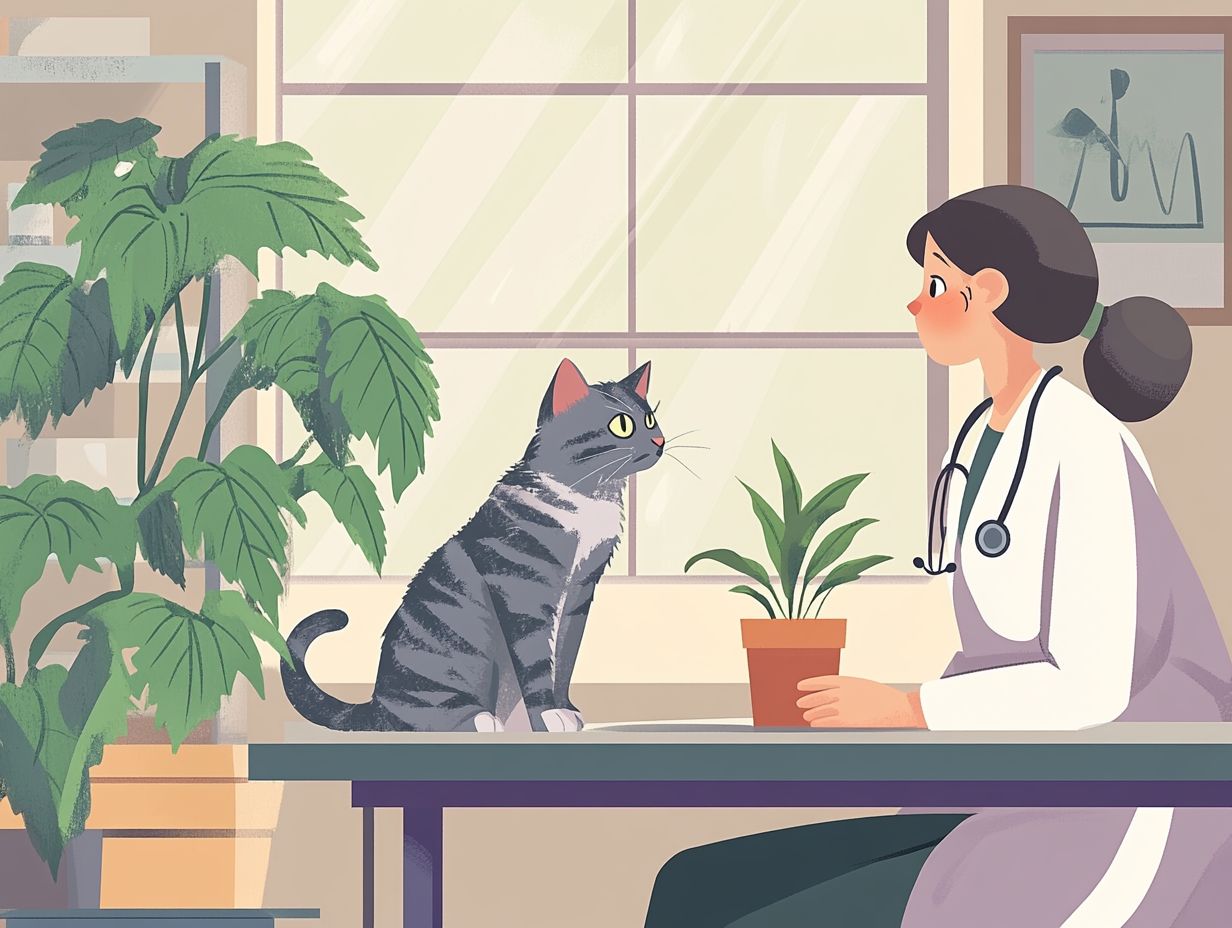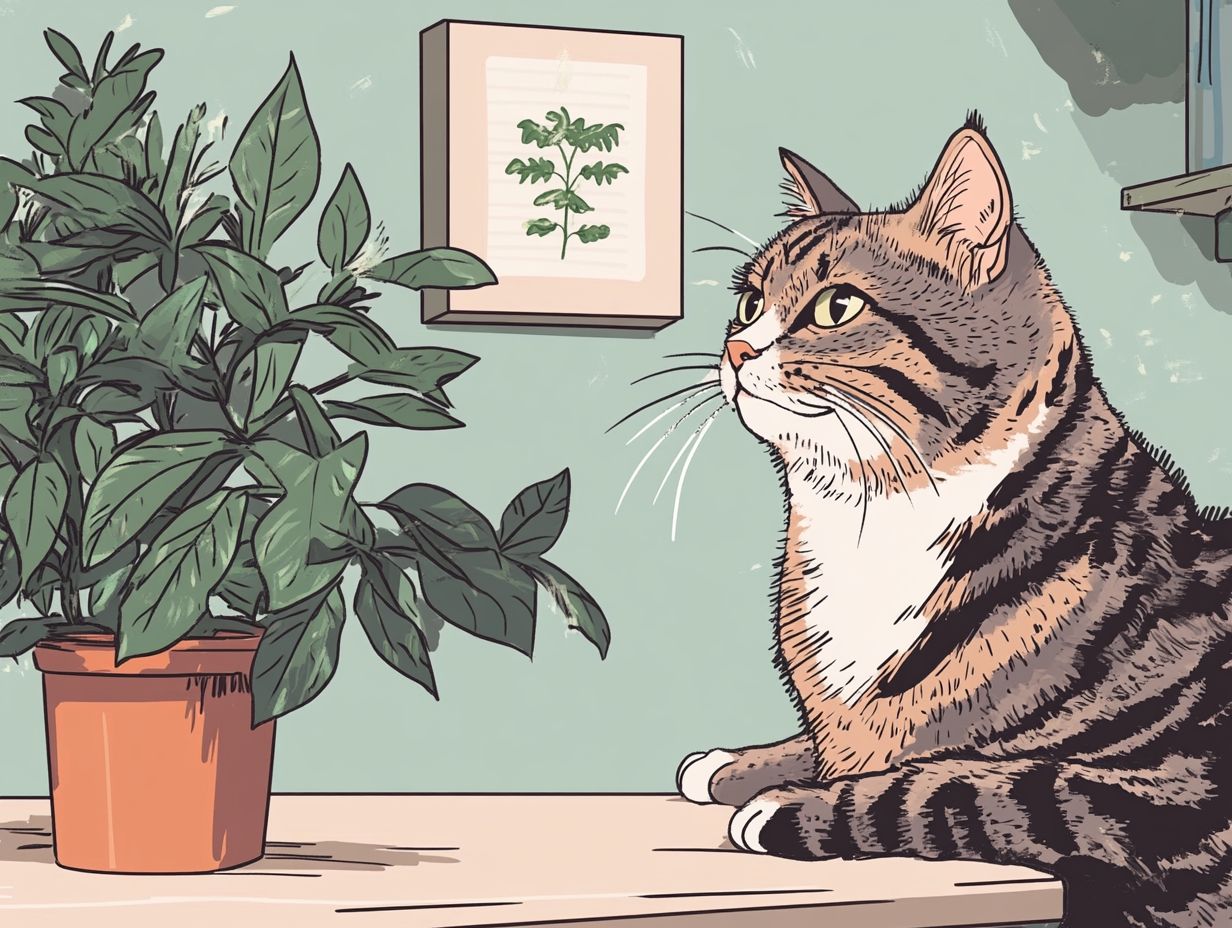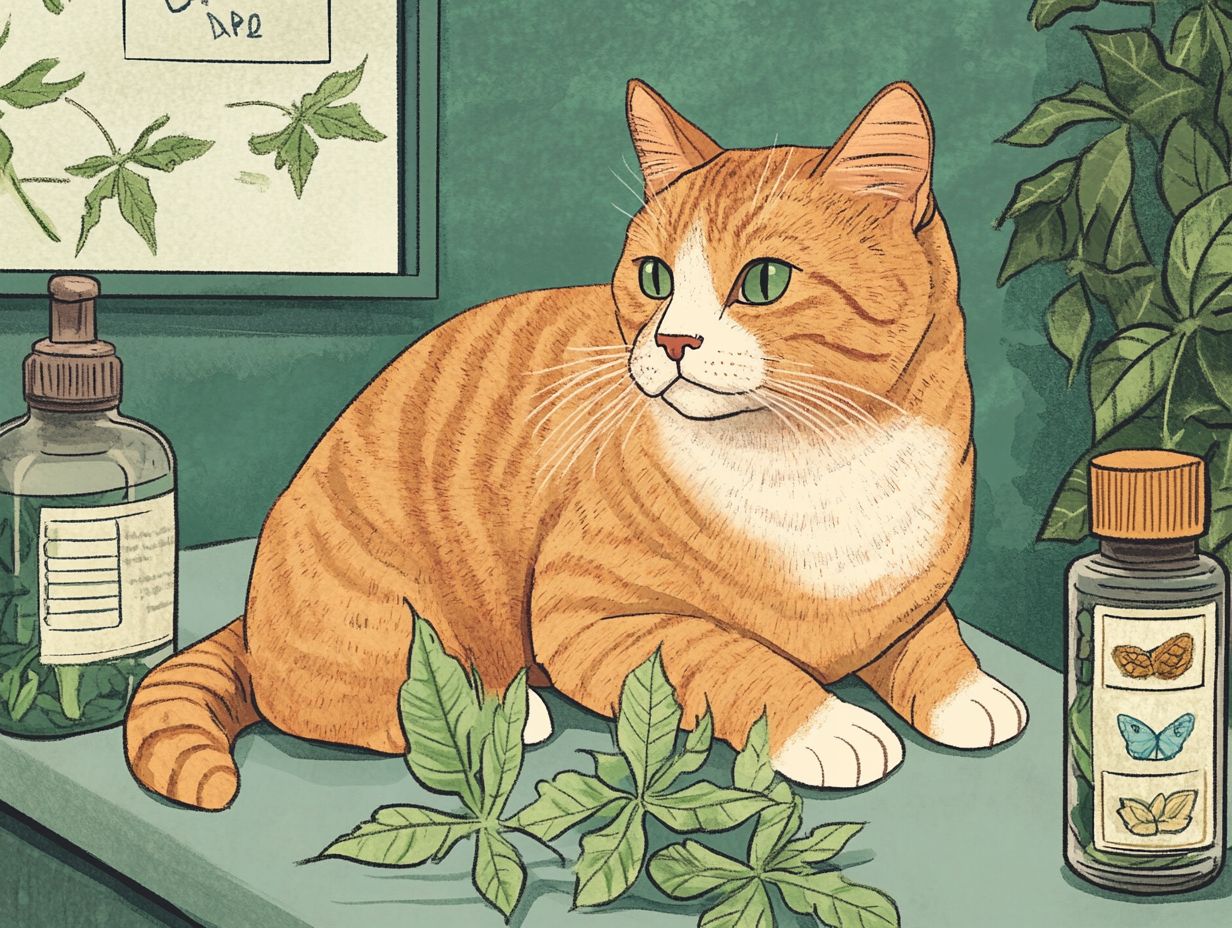Poison ivy is a common plant that many pet owners may not realize can pose a threat to their feline friends. According to the ASPCA’s database, poison ivy is toxic to cats due to the presence of the oil urushiol, which is found in the leaves, stems, and roots of the plant.
While we often associate the plant with human allergies, cats can also experience reactions, raising concerns about their well-being. Urushiol can cause a variety of symptoms in cats, which can be categorized as follows:
- Mild: Localized skin irritation.
- Moderate: Rashes and itching.
- Severe: Vomiting, diarrhea, and serious allergic reactions.
This article explores how cats can encounter poison ivy, the symptoms to watch for, including the potential for long-term effects if exposure is severe, and effective ways to treat and prevent exposure to toxic plants like poison ivy and poison oak.
Understanding these aspects can help you keep your furry companion safe and healthy.
Key Takeaways:

What is Poison Ivy?
Poison Ivy is a plant that contains the toxic oil urushiol, which can lead to severe skin irritation and allergic reactions. This common North American plant typically features a three-leaf structure and is often mistaken for other plants, such as Poison Oak and Ivy Arum. Understanding these plants is crucial for preventing and treating exposure-related symptoms, particularly for pet owners who may share their living environment with these toxic species, including Ivy Arum, which contains calcium oxalate crystals. Proper diagnosis and care can help mitigate the negative effects of this plant’s sap and maintain a healthy living space.
Is Poison Ivy Harmful to Cats?
Yes, Poison Ivy poses a danger to cats due to its toxic oil, urushiol, which can trigger a variety of symptoms upon exposure. Like humans, cats can experience skin irritation or serious allergic reactions after coming into contact with Poison Ivy. Cat owners should be aware of the risks associated with this plant and exercise caution in outdoor environments where their cats may roam freely.
The symptoms of exposure can range from mild rashes to more severe conditions that require veterinary attention, making awareness and prevention essential for pet owners. It is a common misconception that only humans can react to poison ivy; however, cats can also be affected.
How Do Cats Get Exposed to Poison Ivy?
Cats can be exposed to Poison Ivy primarily through direct contact with the plant or indirectly via contaminated surfaces, such as clothing or outdoor gear. When exploring their environment, cats may brush against the leaves, which contain a toxic sap rich in urushiol. If this sap gets on their fur, it can transfer to their skin or be ingested during grooming, leading to increased exposure. This is similar to exposure risks posed by other toxic plants like oleander and azaleas. Therefore, understanding how this exposure occurs is essential for preventing potential health issues in pets.
Adventurous felines often wander into areas where Poison Ivy grows, particularly in gardens, parks, or wooded environments. Their innate curiosity drives them to investigate everything, from rustling leaves to unfamiliar scents, which can inadvertently lead them into contact with this hazardous plant.
To mitigate these risks, it is crucial for cat owners to routinely inspect their outdoor spaces for the presence of Poison Ivy and take proactive measures to remove it. Additionally, keeping outdoor gear and clothing free of plant residues can further safeguard their furry companions. Creating a cat-friendly environment that is devoid of toxic plants not only ensures the health and safety of pets but also allows them to enjoy their explorations without worry.
What are the Symptoms of Poison Ivy in Cats?
Cats exposed to poison ivy may exhibit symptoms such as localized skin irritation, rashes, and itching. In more severe cases, they may also experience gastrointestinal symptoms like vomiting and diarrhea if they ingest the plant or come into contact with it severely.
These symptoms are indicative of a reaction to urushiol, the toxic oil found in poison ivy. If you suspect your cat has been exposed, follow these first aid steps:
- Rinse affected areas with water and mild soap.
- Contact your veterinarian immediately for further guidance.
What Does Poison Ivy Rash Look Like on Cats?

Prevention and Safety Measures
To prevent poison ivy exposure, cat owners should:
- Identify and remove poison ivy from their yards.
- Use barriers to restrict cats from accessing areas where the plant grows.
- Regularly inspect outdoor gear and clothing for plant residues.
Creating a safe outdoor environment is crucial for the well-being of your feline companion, especially during the warmer months when outdoor activity increases.
If you have any concerns or if your cat shows symptoms of exposure, contact the ASPCA Animal Poison Control hotline for guidance.
Disclaimer: This content is for informational purposes only and does not substitute for professional veterinary advice. Always consult a veterinarian for any health concerns regarding your pets.
We will review and update this content regularly to ensure it reflects the latest veterinary research.
Is Poison Ivy Toxic to Cats?
Poison Ivy is considered toxic to cats due to the presence of urushiol, a potent allergen found in various parts of the plant.
Toxic Compounds in Poison Ivy
The primary toxic compound in Poison Ivy is urushiol, which is found in the leaves, stem, and roots of the plant. This oil is responsible for the allergic reactions seen in both humans and cats upon contact.
Symptoms of Poison Ivy Exposure
Symptoms of exposure can vary and are categorized as follows:
- Mild: Redness and mild itching.
- Moderate: Swelling, more intense itching, and potential blistering.
- Severe: Oozing lesions, significant swelling, behavioral changes such as lethargy, and possible gastrointestinal symptoms like vomiting or diarrhea.
First Aid for Poison Ivy Exposure
If you suspect your cat has been exposed to Poison Ivy, follow these first aid steps:
- Immediately wash the affected area with soap and water to help remove urushiol.
- Monitor your cat for any symptoms described above.
- If symptoms develop, contact your veterinarian without delay for further guidance.
Preventative Measures for Pet Owners
To minimize the risk of Poison Ivy exposure, pet owners should:
- Keep cats indoors during high-risk seasons when Poison Ivy is prevalent.
- Train cats to avoid areas where Poison Ivy is likely to grow.
- Regularly inspect your property for Poison Ivy and consider removing it.
Common Misconceptions about Poison Ivy
Many people believe cats are immune to Poison Ivy or that they cannot react to it. However, this is not true; cats can have allergic reactions similar to humans.
Risks for Specific Groups of Cats
Kittens, older cats, and those with pre-existing health conditions may be at greater risk for severe reactions to Poison Ivy. Special care should be taken to monitor these groups closely.
Identifying Poison Ivy
For easy identification, refer to the images below:


For further reading, consult reputable sources such as veterinary journals or recognized toxicology databases.
Disclaimer
This article is for informational purposes only and is not a substitute for professional veterinary advice. Always consult your veterinarian regarding any health concerns for your pets.
Emergency Contact Information
If you suspect your pet has ingested or come into contact with Poison Ivy, contact the ASPCA Animal Poison Control at (888) 426-4435 immediately.
Last reviewed: October 2023
How to Treat Poison Ivy in Cats?
Consulting veterinary care, such as The Village Vets in Atlanta, is recommended for effective treatment strategies.
Treatment for poison ivy exposure in cats involves a combination of home care and veterinary assistance, depending on the severity of the symptoms. Initially, home care may include washing the affected area with soap and water to remove urushiol from the cat’s fur and skin.
If symptoms do not develop after the initial washing, it is important to monitor the cat for signs such as a rash, itching, vomiting, or diarrhea. Should these symptoms persist or worsen, seeking veterinary care is essential to ensure the cat receives the necessary treatment and relief.
What Are the Home Remedies for Poison Ivy in Cats?
Poison Ivy (Toxicodendron radicans) is toxic to cats. The leaves and stems contain a toxic compound called urushiol, which can cause adverse reactions upon contact.
Home remedies for treating poison ivy exposure in cats may include washing the affected area with mild soap and applying cool compresses to soothe irritated skin. Some pet owners may also consider oatmeal baths to alleviate itching and inflammation. Additionally, utilizing home care with Spanish thyme or sage palm extracts can be beneficial for calming skin irritation.
Symptoms of Poison Ivy exposure can vary in severity:
- Mild: Localized rash
- Moderate: Vomiting
- Severe: Difficulty breathing
While these remedies can provide relief, it is essential to monitor the cat for persistent symptoms and seek veterinary guidance if needed. Home care should complement professional treatment options for the best outcomes.
Additionally, applying aloe vera gel can promote healing and comfort. Many cat owners have found that using cooled chamomile tea as a wash helps calm inflamed skin.
When to Take Your Cat to the Vet for Poison Ivy?

If your cat has been exposed to Poison Ivy and exhibits severe symptoms such as an extensive rash, vomiting, or diarrhea, you should take them to the vet. These symptoms may indicate a more serious reaction to urushiol. Additionally, if your cat appears to be in significant distress, very lethargic, or if symptoms do not improve with home care after a few days, it’s time to seek veterinary attention. The earlier you seek care, the less likely complications will arise, and the better the chances are that your pet will receive timely treatment.
Warning signs that indicate a more severe reaction requiring veterinary care include:
- Difficulty breathing
- Swelling of the face or limbs
- Severe itching that leads to self-harm
These symptoms suggest a serious systemic reaction and can also result in secondary infections if left untreated. Veterinarians can assist in diagnosing your cat’s condition and initiate treatments such as antihistamines or steroids to alleviate the allergic reaction. It is crucial to recognize the signs of a systemic reaction because delaying help can lead to more severe consequences, potentially resulting in death.
How to Prevent Poison Ivy Exposure in Cats?
Preventing exposure to poison ivy is essential for protecting the health and comfort of cats, particularly for those that spend time outdoors. Cat owners can reduce the risk by familiarizing themselves with the characteristics of poison ivy and other harmful plants, ensuring that gardens and outdoor areas are free from these plants, and regularly checking their cats for signs of exposure after outdoor outings.
Implementing these preventive measures is a vital aspect of responsible pet ownership.
How to Identify Poison Ivy Plants?
Identifying Poison Ivy plants is crucial for preventing exposure in cats and other pets, and recognizing their main characteristics can aid in this effort. The plant exhibits diverse growth patterns; it primarily appears as a climbing vine that may ascend trees or structures, though it can also trail along the ground.
In spring, the leaves are a bright green, making them easily confused with other plants, so it’s important to stay vigilant. As fall approaches, the leaves change to striking shades of red and yellow, which can lead to mistaken identification.
Informing pet owners about marking the boundaries of areas containing Poison Ivy can be very helpful. Using flags or safe barriers can effectively keep pets away from these harmful plants.
If removal is necessary, the safest way to avoid skin irritation is to wear gloves and protective clothing while carefully digging up the roots.
What Are the Precautions to Take When Going Outdoors with Your Cat?
To reduce the risk of Poison Ivy exposure when taking cats outdoors, several precautions can be taken. First, leash your cat to prevent it from wandering into areas where Poison Ivy may be present. Educating yourself about the plants that grow in your area is also essential. Additionally, keep a close watch on your cat for any unusual behaviors and regularly check for signs of contact with toxic plants. These practices reflect responsible pet ownership.
Understanding your pet’s behavior is equally important, as cats are naturally curious creatures with instincts that drive them to explore new environments. By creating a safe space in your yard that is free from dangerous plants, you can provide a controlled environment for outdoor activities.
First Aid Steps for Poison Ivy Exposure:
- Immediately wash the affected area with mild soap and water.
- Apply cool compresses to soothe the skin.
- Monitor your cat for any symptoms and contact a veterinarian for advice.
For further support, reach out to the ASPCA Animal Poison Control hotline.
Please note that this information is subject to change as new research emerges. Last reviewed: [Insert date].
Implementing cat-safe barriers such as fences or plant markers can help establish safe zones and deter your cat from exploring potentially harmful areas. Training your cat to associate the outdoors with safety and enjoyment will foster a positive experience while allowing for exploration and guidance.
Frequently Asked Questions
Can cats get poison ivy?

Yes, cats can get poison ivy. Although they are not as sensitive to the plant as humans are, they can still develop symptoms when exposed to it. Poison ivy is considered mildly toxic to cats due to the oil known as urushiol found in all parts of the plant, especially the leaves and stems. [1]
What are the risks of cats getting poison ivy?
The risks for cats getting poison ivy are similar to those for humans. They can develop a rash and experience itching and discomfort, but it is not a life-threatening condition for them. The severity of symptoms can vary:
- Mild: Itching, redness
- Moderate: Swelling, blisters
- Severe: Difficulty breathing, facial swelling
It is important to monitor for long-term effects and seek veterinary guidance if severe reactions occur.
What are the symptoms of poison ivy in cats?
The most common symptoms of poison ivy in cats are:
- Mild: Itching, redness
- Moderate: Swelling, blisters
- Severe: Difficulty breathing, facial swelling
What should I do if my cat comes into contact with poison ivy?
If your cat comes into contact with poison ivy, it is crucial to wash them with a mild soap and water to remove the oils from the plant. You can also use a pet-safe skin cleanser or a solution of vinegar and water to soothe the affected area. Avoid using human creams or ointments without veterinary guidance. If symptoms are severe, seek veterinary assistance immediately.
Can cats spread poison ivy to other animals or humans?
No, cats cannot spread poison ivy to other animals or humans. The rash is caused by an allergic reaction to the plant’s oils, which are not transferred through contact with the cat’s fur. Addressing myths like “cats can’t get poison ivy” is essential for accurate pet care.
Should I take my cat to the vet if they have poison ivy?
If your cat is experiencing severe symptoms, such as difficulty breathing or swelling of the face or throat, it is important to take them to the vet immediately. Otherwise, you can monitor their symptoms and provide them with relief at home.
Prevention and Safety Measures
To prevent cats from encountering poison ivy, consider:
- Removing poison ivy from your garden
- Using natural deterrents
Expert Input
According to Dr. [Veterinarian’s Name], “Cats can have allergic reactions to poison ivy, and it’s essential to monitor their outdoor access to prevent exposure.” Consult your vet for personalized advice.
Special Considerations
Kittens, senior cats, and cats with existing skin conditions may be more susceptible to severe reactions and should be monitored closely.
Call to Action
If you suspect your cat has encountered poison ivy, contact the ASPCA Animal Poison Control at (888) 426-4435 for immediate assistance.
Last updated: [Insert Date]
This content is for informational purposes only and should not replace professional veterinary advice.
Related Topics
For more information, check out these links on other plants toxic to cats and skin allergies in pets.